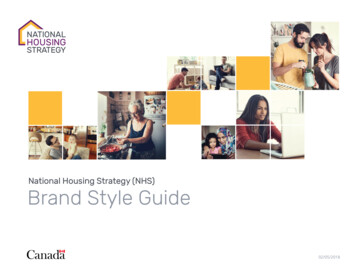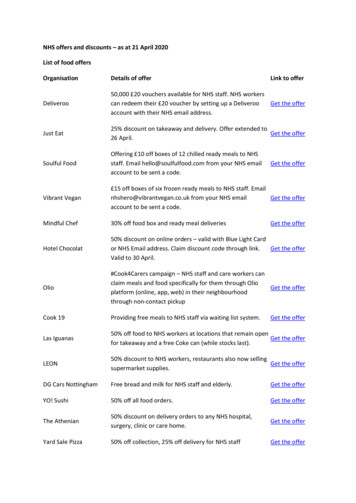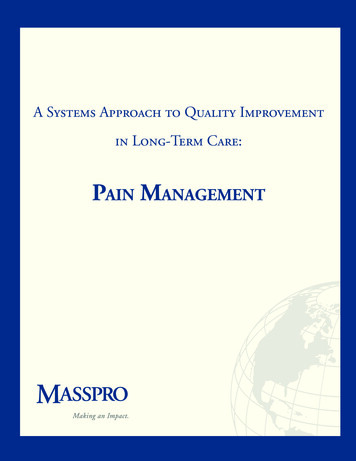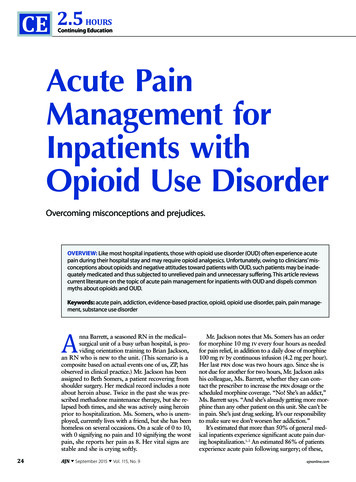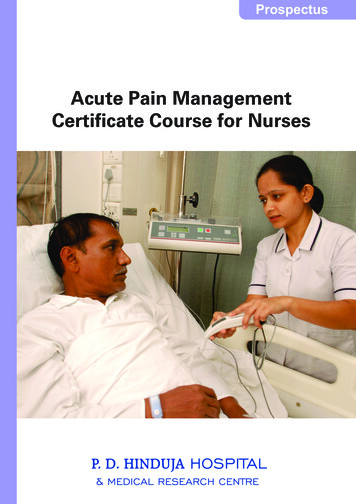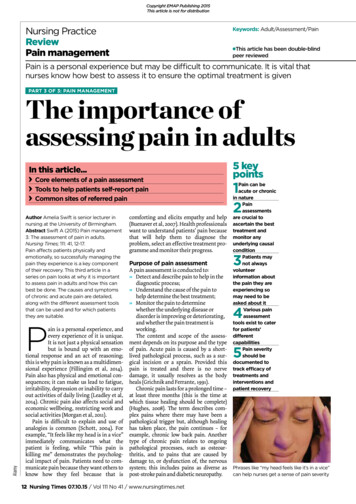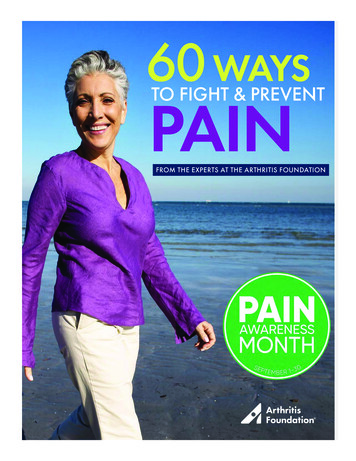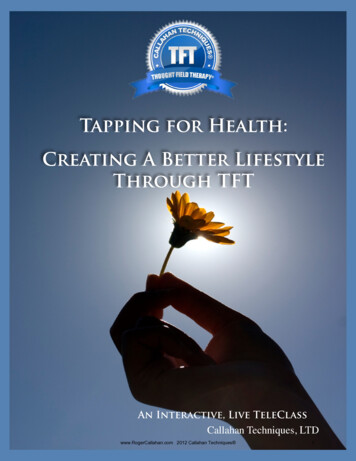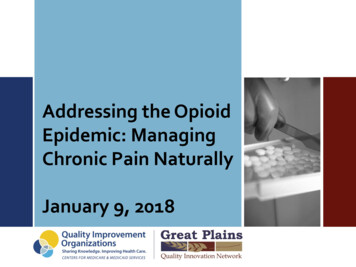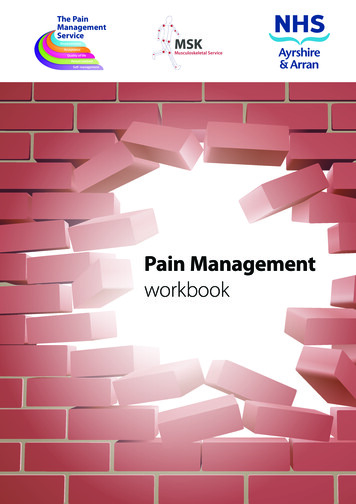
Transcription
The PainManagementServiceEmpowermentAcceptanceQuality of lifePerson-centredSelf- managementPain Managementworkbook
IntroductionPersistent pain has a considerable impact on the quality of life for many peoplein Scotland.This workbook is an introduction to understanding why we have persistent painand what we can do about it. Having up to date, scientific and usable knowledgeabout pain is a powerful treatment. You can then use this knowledge to changethe things you do, think, say and of course, your level of pain.This workbook should be used and discussed with your therapist and brought toeach session.Each section of this workbook explores a different concept about painmanagement alongside sections that you can work through independently orjointly with your therapist.Why?This book is a starting point to improving the management of your persistentpain. We know that if you can improve your understanding of pain and the factorsthat influence your pain, then this can lead to improved function and quality oflife. This workbook is part of a comprehensive treatment approach that can mixlifestyle changes, thoughts about pain, goal setting, managing activity, flare-upmanagement, sleep, manual therapy and exercise.Let’s start with exploring your pain journey so far.In this first section it is going to be worthwhile reviewing the treatments thatyou have had as well as the sacrifices that you have had to make along the waybecause of your pain and its effects on you.While doing this exercise, it is worth considering the other things that you havedone to try and not have pain. This could include stopping work, not meeting upwith friends, and so on.2
Type of paintreatmentShort-term effectson painLong-term effectson painLong-term effectson quality of lifeWhen you have completed all of the above, what conclusions do you come to?Many people find that, despite their best efforts and the help they have receivedfrom doctors, nurses, physiotherapists, psychologists, their friends and family, thatthey are still left with a substantial degree of pain. They also often find that seekinghelp and searching for a cure comes with its own problems. People with chronicpain often feel increasingly desperate as time goes on and their pain continues.Each failed new treatment makes this feeling of desperation worse. Sometimesthese treatments can produce significant problems of their own, such as side-effectsfrom medicine and discomfort from procedures and exercises that they have tried.Thinking over this might well make you feel more fed up about your situation.However, we have not done this exercise to show that nothing works in the longerterm for chronic pain, but mainly to highlight the costs to you of trying to avoidpain. All of the effort involved in seeing different doctors, trying different medicineswith different side-effects, cutting back on things in order to avoid pain, has3meant that life has become increasingly difficult and restricted.
MetaphorTug of war with a monsterImagine you are in a tug of war with some huge anxiety/pain monster. You haveone end of the rope and the monster has the other end. In between you thereis a huge bottomless pit. You are pulling backward as hard as you can, but themonster keeps on pulling you ever closer to the pit. What is the best thing todo in that situation? Pulling harder comes naturally, but the harder you pull, theharder the monster pulls. You are stuck. What do you need to do? Dropping therope means the monster is still there, but you are no longer tied up in a strugglewith it. Now you can do something more useful.Some experts in chronic pain make the distinction between two kinds of suffering.There is the original suffering, from the pain/injury/accident (we call this primarysuffering), but there is also the suffering that has been caused by all of the thingsthat people have done to avoid or control this pain and the impact that this hashad on your life (this is called secondary suffering).When people with pain experience an increase in their pain, they also oftenexperience other reactions. There is the mental reaction, the emotional reactionand the effect this has on the things the person is prepared to do (and not do).For example, a sharp pain from bending might produce a number of upsettingthoughts, such as “now I can’t even bend anymore. How am I going to be able topick up my grandchildren if I can’t get down to them? What kind of grandparentam I?” These reactions are understandable. These thoughts are likely to beaccompanied by a lot of sadness and even tears. This could be so off-putting thatthe person becomes reluctant to meet with their grandkids anymore because itmakes them feel bad.These reactions accompany the pain, but are not the pain. Although thesereactions are understandable, they might not be necessary. These reactions arelikely to have been immediate and have seemed inevitable, but are they really?Part of learning to accept the situation is learning not to be pushed around bypain, including not reacting to pain so drastically, but having a calmer response.4
Persistent painLow mood andnegative thinkingAnger, fear andfrustrationTime off work /family /moneyworriesFatigue and lackof staminaSleep difficultiesMedicationStress, anxietyand tensionWeight concernsWeak musclesand loss of fitnessInactive/overatctiveThe sad truth is there are some unpleasant things in life that cannot be controlledand, unfortunately, sometimes it is impossible to control pain. The worst thingabout this is that struggling to control the uncontrollable always produces itsown set of problems. Later on, you will hear about how efforts to avoid pain canactually lead to more pain.Can anything be done? The good news is yes, the bad news is that it is hard andmeans a big change in your attitude to pain. What we hope to do in this workbookis to help you make that difficult change in attitude towards pain. At the sametime, we want to help you recover those other parts of your life that have beenaffected by the struggle with pain.5
MetaphorThe bear and the blueberry bushImagine you are following a path through a forest. You have been following thepath for several hours and you are not exactly sure where you are going. Alreadyon the journey there have been some enjoyable moments, but there have beensome unpleasant moments that may have been scary and worrying. Right nowyou know you are tired and hungry.Then you come to a fork in the path, which splits off in two directions. When youlook down one path you see it is bathed in sunlight with a tall lush blueberrybush. When you look down the other path you see shadows and an enormousgrizzly bear.This is not a trick question. It is normal human behaviour to choose the pathwith the blueberry bush. Very few people would choose to be in direct contactwith a grizzly bear. This is common sense – it is part of human behaviour to benaturally motivated towards things that are pleasant and avoid stuff that is or feelsthreatening. This approach works in the short term as there is a sense of relieffrom not having to put up with those horrible thoughts and feelings. The trap iswhen this is applied and our lives become very limited. Nothing changes, you donot do the stuff that matters most, and you do not grow, develop or push yourself.What is pain?We all experience pain, some more than others, and there are many kinds ofpain. There can be sudden pain when we fall and cut our knee or twist our ankle.This is sudden. Pain can be unpredictable - for example, you could lift an objecthundreds of times without a problem and then, without warning, one lift causespain. Pain can also start with no obvious injury - for example, someone who hasworked in an office for 15 years who starts to get neck pain.Pain from sprains, cuts and posture are everyday pains. The brain concludes thetissues are under threat, so we change our posture or rest our sprained ankle toallow healing and the pain lessens. We remember the uneven ground we trippedon or the posture that caused the pain, our memory helps to protect us frommaking the same mistake twice.Pain can also be a more complex experience. It can be amazing and confusing!We have all heard stories of people in the Emergency Department with objectslike six inch nails through their hand. When you look at the nail passing throughthe damaged tissues you think there must be pain, but when asked they reportlittle or no pain. Injury sends messages to the brain via the nerves, but this does6 not necessarily result in pain.
The ratio of the amount of injury to the amount of pain swings the other waytoo. All of us will have had a paper cut. We know how painful they can be but atthe same time we struggle to see where the cut is. It can be hard to believe thatsuch a little cut can cause so much pain. This is one of the confusing bits aboutpain. The pain you experience does not necessarily relate to the amount of tissuedamage. It can be difficult to understand and accept that pain does not alwaysmean harm.People who live with persistent pain have told us that learning a little more aboutpain and the nervous system helps them manage their pain better. So here goes The nervous systemAll over our skin we have receptors. These are nerve endings or ’danger sensors’.Different receptors pick up different information. Some react to temperature,some to pressure. The information that the receptors pick up is sent through thenerves to the spinal cord. The message that is sent is more like a question asking“How dangerous is this really?” Not all messages are sent. We are not aware ofevery time we are touched; we do not constantly feel our clothes on our skinand sometimes we cannot remember getting the bruise that we discover on ourleg. The spinal cord acts a little like a postal sorting office and decides when andwhich ‘danger?’ messages are sent to the brain. When enough ’danger?’ messagesreach the spinal cord, the message is sent to the brain.The brain processes the ‘danger?’ messages and decides if the body is at risk ofharm or injury. If the brain decides the body is at risk we will feel pain and reactto get ourselves out of danger. If our hand touches something hot, like a kettle,the ’danger sensors’ will send messages to the brain. Our tissues are not designedto withstand much heat, so to protect the tissues our brain sends a response ofpain and we very quickly remove our hand. We will remember that kettle and nottouch it, especially if there is steam coming out of the spout!It is sometimes easier to think of how the danger sensors and the brain combinetogether to form an alarm system. As we have discussed with the stories aboutthe six inch nail or the paper cut, pain does not always equal harm, so when wetalk about the nerves sending messages, instead of thinking of these messagesas pain signals, we like to call them ‘danger?’ messages. It is the brain’s use of thisinformation from the alarm system that results in the feeling of pain. The brain isworking out “How dangerous is this really?”So, why does it hurt?Most of us will have sprained an ankle at sometime in our lives or know someonewho has. Remember how quite quickly after the injury the area became swollen,red and tender to touch? This is because of all the chemicals involved in healing7
arriving at the injury site to do their job and start the healing process. This isinflammation. These chemicals irritate the nerves, making the area tender totouch. This reaction has a protective role. The first few days after the sprainedankle you may have rested more or even used crutches to ease the pain whenwalking, this allows the injured tissues time to heal.Over time, as healing takes place, we can walk more, and then jog, and later run tocatch the bus or return to football training. There was a useful reason for this pain.It meant we rested the injury and allowed the tissues time to heal. As the healingtakes place, the chemicals stop being produced and so should the pain.This process takes time but the tissues heal, the body is very good at this. Alltissues in our body will eventually heal. A broken bone will heal in six weeks,tendon and ligament injuries within six to twelve weeks. The body will continue toremodel a scar for three to six months after it is healed.So, why does the pain last after the tissues are healed?Researchers have learnt more about pain in the last 10 years than in the last 100years. They can see what changes happen in the nervous system that producepersistent pain, even though the tissues are completely healed. For some peoplethe pain starts without damage to the tissues. Unfortunately, we do not fullyunderstand why this persistent pain starts.So, what is happening in the tissues to cause the pain?The brain continues to receive the ‘danger?’ message; it thinks that the tissues arestill under threat of damage. The brain decides the body needs all the protectionit can get. It starts to build more defenses; it upgrades the alarm system. It needsmore information from the tissues, so it creates more ‘danger sensors’. The brainthinks, the more information the better!More ‘danger sensors’ create more ‘danger?’ signals. All these messages are sentto the spinal cord. The spinal cord or postal sorting office becomes overloadedwith messages, it starts working overtime to deal with all the extra messages.It becomes quicker at processing the messages and sends out more deliveries,allowing more of the messages to be sent out as soon as they arrive. Before itwould have been more selective of which messages needed to be sent. The spinalcord is now starting to amplify the signals it receives from the tissues.Our brain receives more messages, it becomes better and quicker at recognisingthe ‘danger?’ messages. The alarm system stays on high alert. This now means thatwe receive the pain message more often. Pressures and movements that did notused to hurt now hurt and things that hurt now hurt more. The alarm system isnow going off when someone taps the window, instead of only when the window8 breaks.
As time goes on The pain starts, it does not go, and you becomeworried. In the past when you had pain yourested, so now you do the same and avoidmovement to protect the area and avoidmore damage.The pain stays; you keep the reduced level of activitybecause any time you try to do more it hurts. Your musclesand tissues become weaker and less flexible as they getused to doing less. When you walk further than normalyou become out of breath, hot and sweaty. You find thatyou can no longer do things that you used to find easy.Also when you become active, it takes less to stress your muscles and tissues,which are now tighter and less fit. When the tissues are stressed they release‘danger?’ chemicals - as the brain is now on alert and quicker at recognising thesesignals, it is more likely to send a pain message.Tighter tissues, weaker muscles and lots of ‘danger?’ chemicals irritating the overexcited alarm system; it is not surprising that the smallest stretch starts to feel sopainful. Even though the tissues are healed, you feel pain. This pain can often feelexactly like the pain you had when you initially had your injury. This familiar painhelps to reinforce the thoughts that there must be something wrong; there mustbe damage to the tissues. Hopefully, now we know that this is not always true,and pain does not always mean harm.Pain and your memoryPain memory can be very powerful. A well known pain researcher, LorimerMoseley, tells the story about when he got bitten by a snake. He is an Australianand was on a camping trip in the “bush”. He got up one morning and was walkingto the river to have a swim when he felt something scratch his leg. He thoughtnothing of it but shortly started to feel unwell. He ended up in hospital for a fewdays but recovered well apart from pain in the leg where the bite was. This, overtime, lessened and eventually disappeared.A couple of years later he was walking with friends in a forest park. He felt ascratch on his leg, the sensation felt identical to the snake bite. He panickedbelieving he had been unlucky enough to be bitten again. He got all his friendsto search for the snake to identify it. He started to feel pain in his leg, just like thepain from the snake bite, but no one could find the snake. He looked at his legand realised there were no bite marks, just a scratch from a tree branch. The painin his leg started to lessen.9
Lorimer tells this story at a lot of his lectures. I think he is amazed at how hisnervous system reacted to the ‘danger?’ message from the scratch. That he couldfeel so much pain from so little damage. This man knows almost all there is toknow about pain, but his body still reacted immediately, well before he had timeto think about what was happening. This shows how powerful the ‘danger’ alarmsystem is in producing pain and making us act in ways that we think will protectus from further harm.Hopefully you can see that persistent pain is definitely not in your head, but thatthe brain does play an important role in what we feel as pain and how we react toit. If we had no brain, we would feel no pain!Thoughts and feelings as added extras Thoughts and feelings are often involved too (the brain involved again!). A lot ofpeople living with persistent pain say that it affects their mood. Over time theyhave started to feel low, anxious, irritable or even forgetful. Some people haverealised that when they feel like this their pain feels worse too.Researchers have shown us by doing very detailed scans of the brain that whenwe are in pain certain areas of our brain becomes active. These areas are the sameareas that become active when we are stressed, anxious, depressed or angry. So, ifyou add anger or depression to persistent pain those areas in your brain becomemore active. It is like having a 100 watt bulb in your brain instead of a 40 watt one.On the flip side, a pain patient once said that his pain felt a little easier when hewatched The Three Stooges. So when we feel happy and relaxed it is possible todim down the 100 watt bulb! When we are happy or relaxed, endorphins (naturalpain relieving substances) are released in our bodies. This is one reason whyrelaxation techniques and doing activities you enjoy and value are an importantpart of your pain management tool kit.So the pain we feel is not just to do with tissue damage, in fact as we havementioned earlier it is possible to feel pain even without injury to the tissues.If we go back to the question the alarm system is asking - “How dangerous isthis really?” - we can hopefully see that there are lots of factors that influencethis question - for example, if the alarm system is on high alert (sensitisation),memories of previous experiences, tight muscles, thoughts and emotions. Allthese factors can mean the nervous system assesses more threat and, therefore,we can feel more pain.As previously discussed we now know that multiple factors influence the onset,duration and severity of an individual’s pain. The image below shows a modelcalled the bio-pyschosocial approach towards pain. It highlights some commonproblems that have been recognised as key factors towards decreasing function10 and quality of life of patients with persistent pain.
Bio-medicalPsychologicalSocialMovement RestrictedFear of movementFamily issuesDecreased StrengthAvoiding activitiesWork problemsLoss of FitnessDepression/ stress/anxietyStopping hobbiesWorkbook taskCan you identify from the previous image with some of the parts that may beimpacting on your condition? There are many factors that that contribute towardsyour pain, however, we often do not realise this. From the previous section, wediscussed that curing all pain may be unachievable, however, the majority of theexamples from the above model can be improved with structured rehabilitation.You may find it useful to consider some of these factors within your owncircumstances and document them within the model. This can then be discussedwith your therapist in order to plan how to address these.Bio-medicalPsychologicalSocialWhat does this mean for the future?As discussed before, when the pain stays, there are more messages and thebrain becomes better at recognising the messages and quicker at processing thepain signal. The alarm system is on high alert as a way to protect us from whatit assesses as potential threat. The alarm system is trying to answer the question“How dangerous is this really?”There are systems in the body that lessen the level of threat the alarm systemperceives., A good example of this is endorphins, which are released when wedo things we enjoy, relax and exercise. This pain management workbook willhelp you look at other strategies to help increase flexibility and function, ways11
to manage unhelpful thoughts and emotions and identify the links between ourmemories, our behaviour and pain. Many of these strategies can alter the level ofthreat the alarm system perceives.If you think of the brain as an orchestra, which can play many types of music(classical, jazz, folk, rock), it can play many different tunes in many different keysand tempos. Pain is just one of the tunes the orchestra can play.If the orchestra plays the same tune over and over, it becomes automatic, it goesby memory, and no one uses the sheet music or even looks at the conductor. Itbecomes very difficult for the orchestra to play anything else. We have all had thatannoying song going round in your head. If you try to think of a different tune yousomehow end up humming the first tune.What we need to do now is remind the nervous system and brain that it can playanother tune, it can play lots of different tunes and can play them really well!Values and valued goal settingLots of things will have changed since you have had your pain problem. Somepeople who have had pain for a while feel that they have changed as a person andthat their old self would not recognise the person they have become. Even thosewho feel that they are essentially the same person today as they used to be wouldadmit that there have been lots of changes in the things that they do.It is also true that what we do says a lot about the kind of person we are. So ifthere have been changes in what we are able to do, sometimes there is the feelingthat we have changed too. Perhaps other people might see us differently or treatus in different ways to how they would have done in the past.Below are a number of common changes that happen when people have hadpain for a long time: Doing less overall. Giving up on things they used to like doing. Being unable to do things that really matter.These changes may well have made you feel sad, frustrated or even angry.Pain can make you realise what things are important and what things are less so.However, sometimes this understanding can get lost in the day-to-day struggle ofliving with pain.One of the major aims of this workbook is to help you to be able to do more whilehaving pain. However, it does not make sense to do more of just any old thing.12
Rather, it is sensible to do more of the things that you really care about. This nextexercise is to help you to be clear in your own mind about what parts of your lifematter the most to you.It is common to compare what we used to do in terms of leisure activities such ashill walking, going to the gym or going out to the pub with friends, and thinkingthese activities seem out of our reach at the moment. The important thing is toremember why we did these activities in the first place. It might have been thatyou enjoyed hill walking because you are someone who values the outdoors andnature, or that going to the gym was because you valued being someone wholooked after themselves.The exercise below will help you to understand this further and simply involvesusing your imagination (and, of course, filling in the table below).Imagine that you are living in the time of space travel and, for whatever reason,you have to take a journey to another galaxy. The galaxy is a long, long, long, wayaway (approximately 2.6 million light years away) so communication back home isgoing to be impossible and it will be years before you return. Naturally, a big partyis arranged in order to give you a proper send off. At the party, you see all yourfamily, friends, old work colleagues. Everyone is chatting away, sharing stories andlaughs when someone starts tapping a glass and bringing the room to order andthe farewell speeches start. One after another, you see your family and friendstake the stand and say what they are going to miss about you while you are away.“I’m going to miss {your name here}” and so on. You hear lots of people saying“What I’ll remember {your name here} for is ”Now the big question what would you like to hear them say about you?You might want to hear them say that you were always a good friend or a goodparent/ son/ daughter and so on. You might also want them to say that you werealways interested in other people, or you were someone who always worked hard.Perhaps they will say you were brave, kind, curious, whatever. What sorts of things came up during the exercise? What did people say? What do you want to be remembered for?The kinds of things that you will have come up with are known as your values.That is, they tell us the parts of your life that are most important to you.When you are doing this exercise it is important to bear a few things in mind.Firstly, values are things that define you. They are what you find inspiring anddescribe how you would like you to be. They are not just desires -for example,being rich, or even being pain-free, and they are different from goals. Goals are13
things that tell you that you are a step along the way towards living a life thatagrees with your values. A good example is, if someone were to say that ‘beinga good parent’ was their value, then they might set the goal for themselvesof spending more time with their kids. A goal is a signpost along the way. It issomething that you can actually achieve. We will look at setting goals later in theworkbook.A good tip for finding out if something is a value or not is to consider if you wouldwant to see it written on your tombstone.Speech exerciseWhat did they say? For example, ”She/ he was always so generous with their time.”1.6.2.7.3.8.4.9.5.10.In the meantime, it is worth considering how successfully you are living by yourvalues at this moment in time. We want to know what are the most importantareas of your life, as well as which areas are most affected as a result of your pain.Most people identify values in the following areas: Couples/ intimate relationship Parenting14 Family (other than marriage and parenting)
Friends/ social life Work Learning/ education Hobbies/ fun Spirituality Physical care (diet/ exercise) Appreciating art, music, literature Getting into natureThe farewell speech exercise may have started you thinking about what isimportant to you. You may have identified lots of aspects of your life that areimportant to you, and perhaps some of these have been affected by your painover the years. By identifying these as part of the workbook we would then talkabout how you can move towards these valued areas.However, you might already have recognised lots of areas which are veryimportant to you but the next step is to identify which of these areas is the mostimportant, and which of the areas you are least satisfied with.Some areas may be important and going well -for example, learning may beimportant to you, and if you are enjoying a course at the moment you may besatisfied with this area. Some areas may be fairly unimportant and not going sowell - for example, you may have a very limited relationship with extended familymembers but you may actually be reasonably content with this. The areas we aremost interested in are those areas that are important to you but are not goingso well - for instance, it may be really important to you that you can go to thecountryside once in a while, but you have not done this for many months. This iswhere we want to start directing your energies so that you can feel like you aremoving towards something that really matters to you.Below are two questionnaires that will help you to identify which areas areimportant to you and how satisfied you are with those areas.Valued living questionnaire – 1Below are areas of life that are valued by some people. We are interested in yourquality of life in each of these areas and how important these areas are to you.Rate the importance of each area (by circling a number) on a scale of 1 to 10. 1means that area is not at all important and 10 means that area is very important.Not everyone will value all of these areas, or value all areas the same. Rate eachaccording to your own personal sense of importance.15
AreaNot importantNot importantCouples/ intimate relationships12345678910Parenting12345678910Family (other than marriage andparenting)12345678910Friends/ social life12345678910Work12345678910Learning/ education12345678910Hobbies/ fun12345678910Physical care (diet/ exercise)12345678910Appreciating music, art, literature12345678910Getting into nature12345678910Valued living questionnaire – 2In this section, we would like you to give a rating of how satisfied you are witheach of these areas. We are not asking about your ideal in each area. We are alsonot asking what others think of you. Everyone does better in some areas thanothers. People also do better at some times than at others. We want to know howyou think you have been doing during the past week. Rate each area on a scale of1 to 10. 1 means that you are completely satisfied with your value. 10 means thatyou are not satisfied with your value.16AreaSatisfiedNot satisfiedCouples/ intimate relationships12345678910Parenting12345678910Family (other than marriage andparenting)12345678910Friends/ social life12345678
This workbook is an introduction to understanding why we have persistent pain and what we can do about it. Having up to date, scientific and usable knowledge about pain is a powerful treatment. You can then use this k

